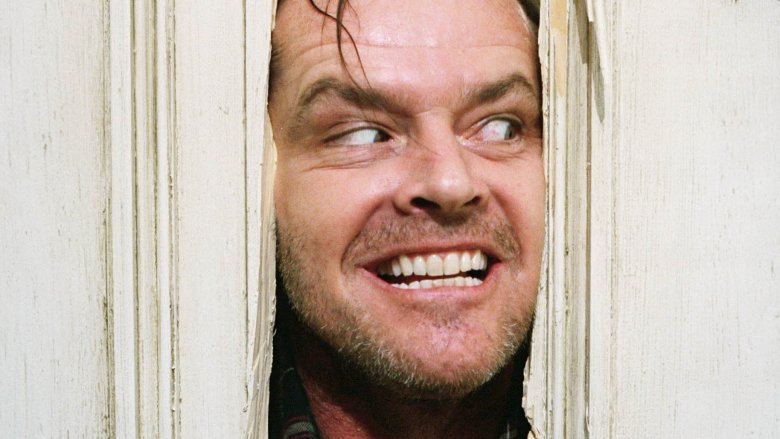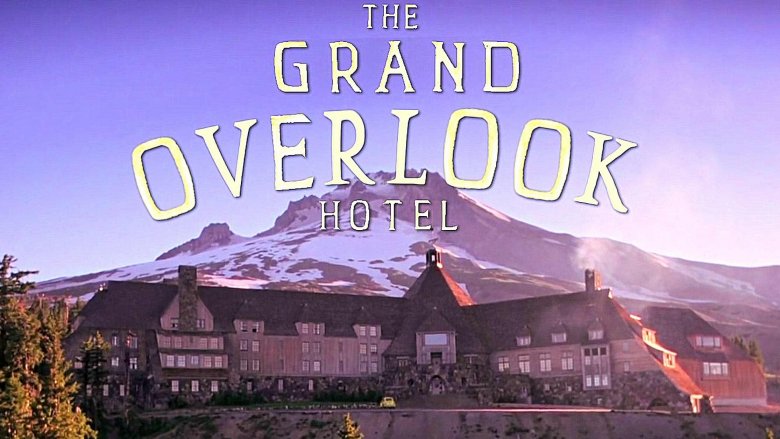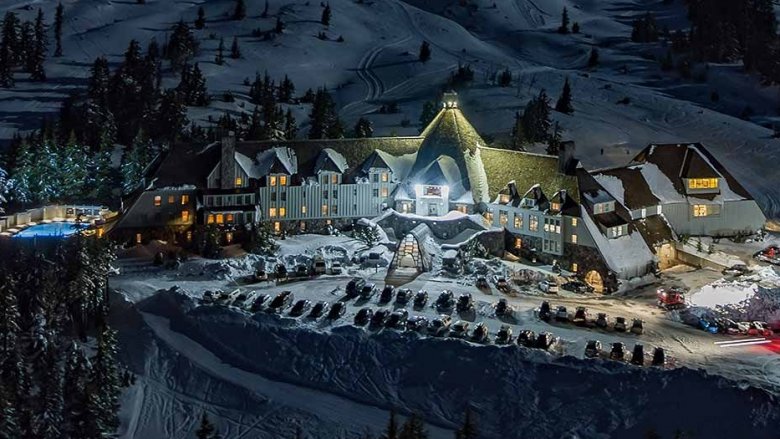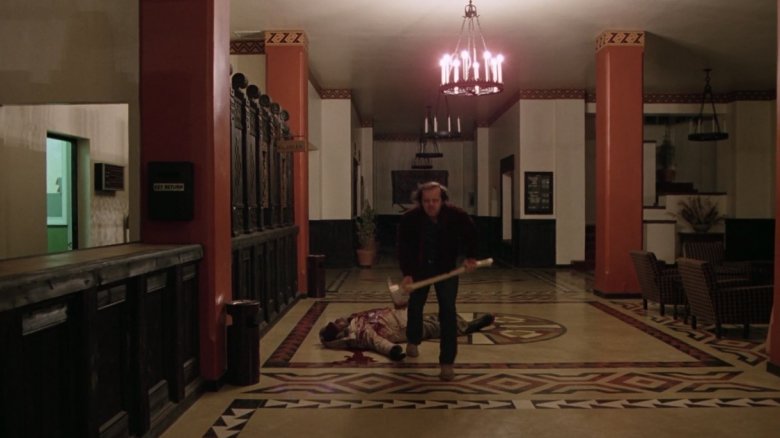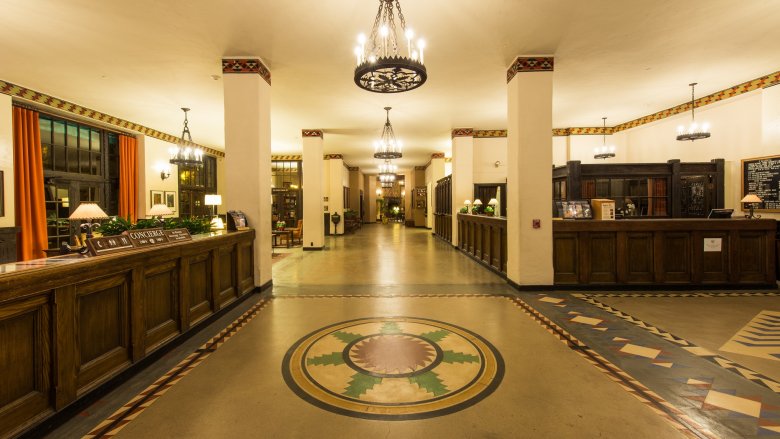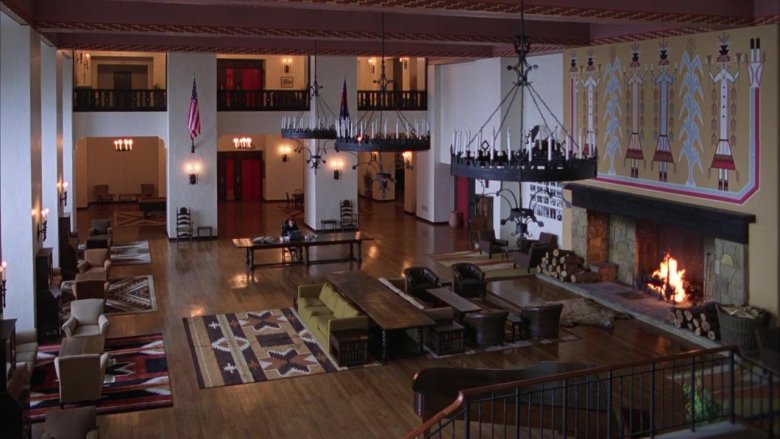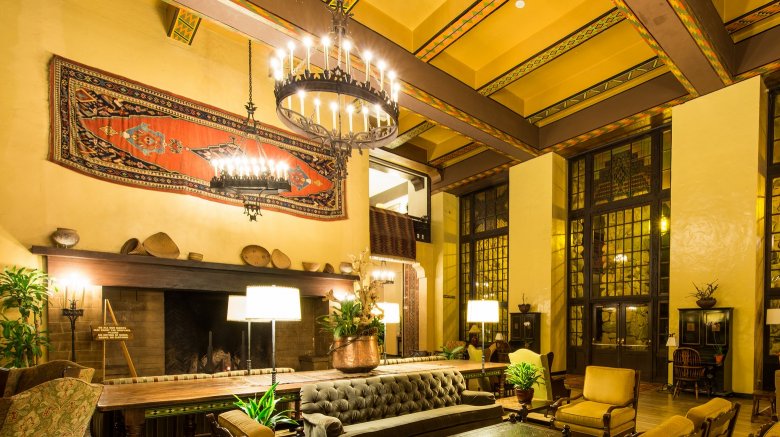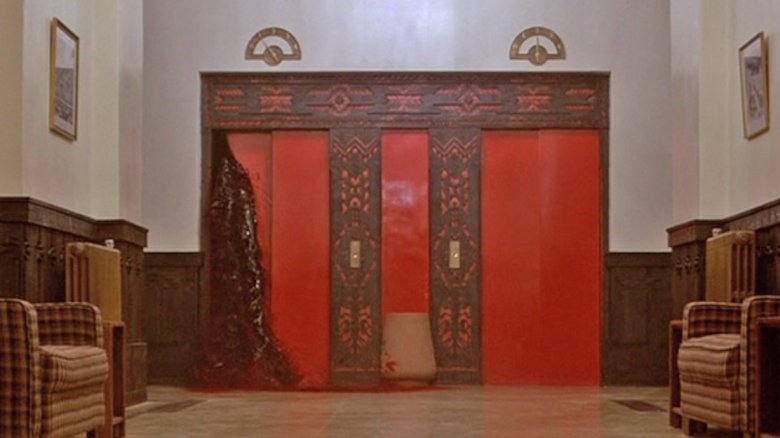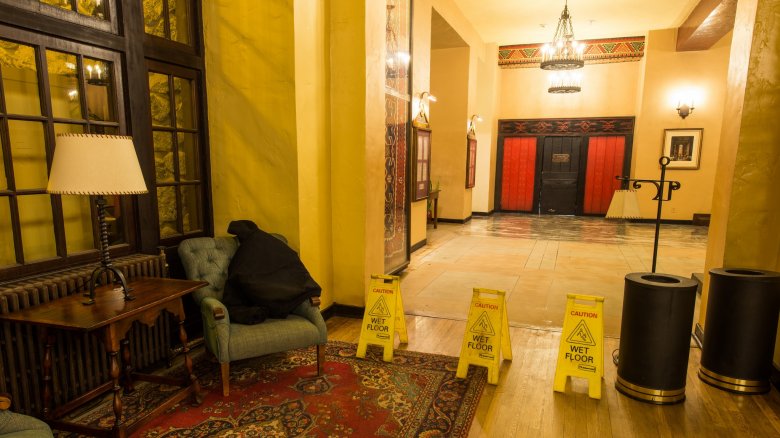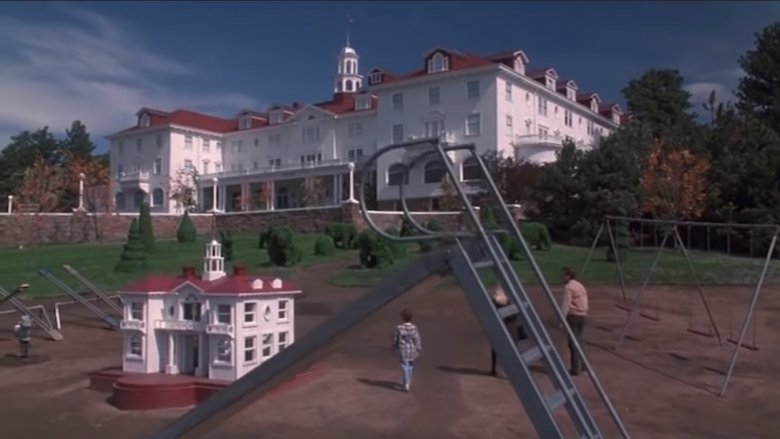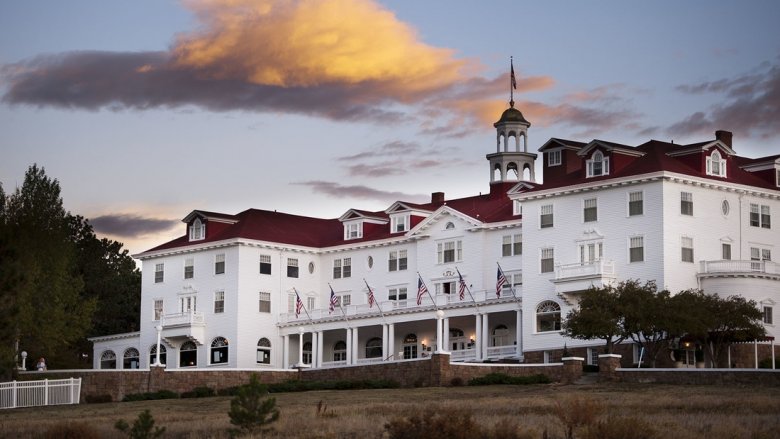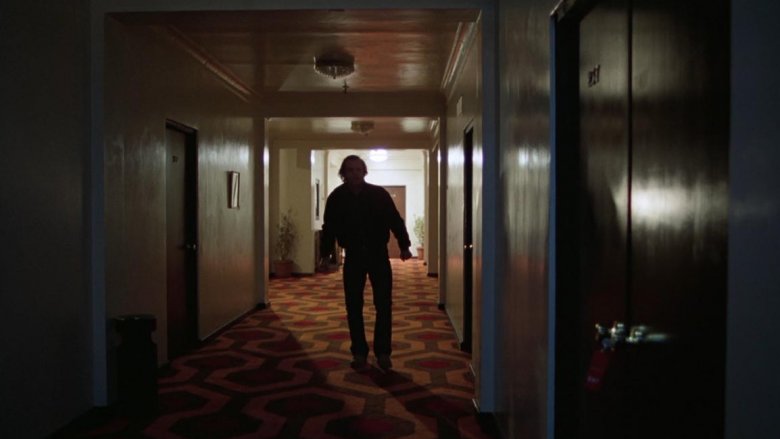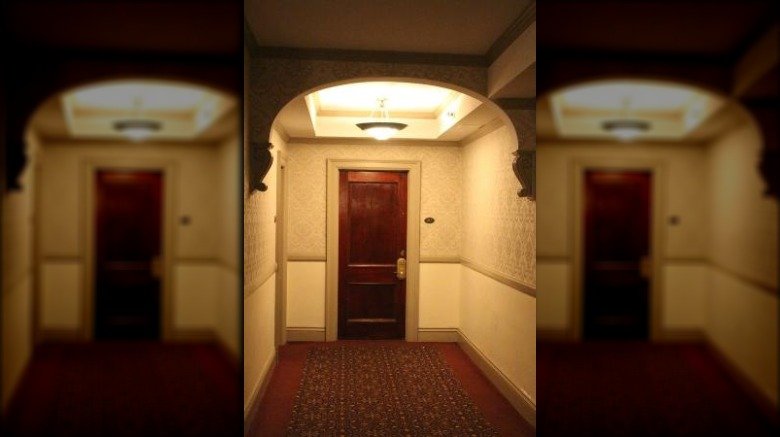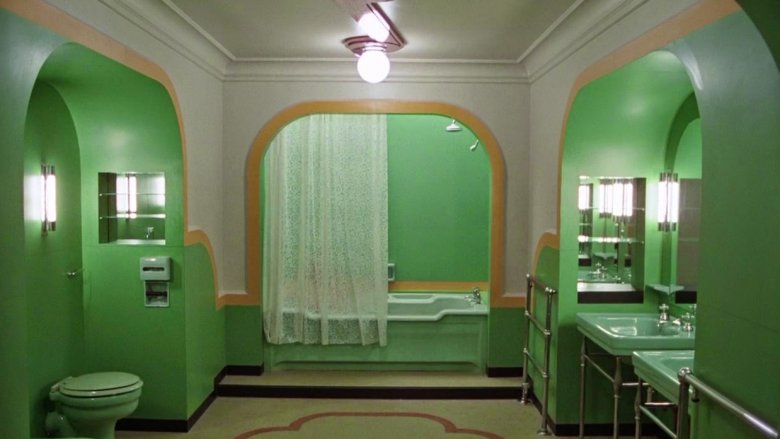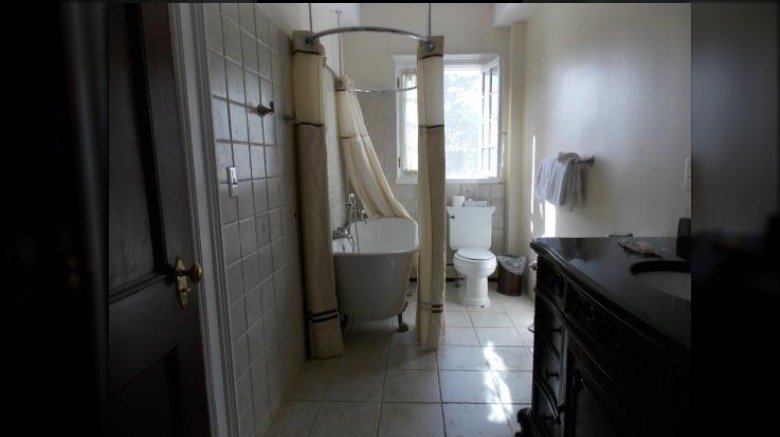What The Hotel From The Shining Looks Like Today
When you think of that hotel from The Shining, any number of memorable images might cross your mind. Perhaps you see a snow-covered hotel made of grey stone, or a grand red-roofed building with a large front porch. Maybe a vision of blood pouring from slowly opening elevator doors comes into view. These, and many more scenes of the supernatural, took place within the confines of Stephen King's fictitious Overlook Hotel.
Made even more famous by legendary film director Stanley Kubrick's 1980 movie adaptation, the Overlook isn't just one place. It's actually three separate locations, each with its own stories and place within the legend of one of the most harrowing tales of cabin fever ever. If you're curious about the real-life origins of the menacing murder hotel, we've uncovered the stories behind the scary scenery and found the real-life locations that inspired them, revealing what the hotels from The Shining look like today.
Ain't life grand at The Overlook?
When Stephen King's third novel The Shining hit the shelves in 1977, it became his first hard-cover best-seller. Followed by The Stand in 1978, these books cemented King's place as the preeminent popular horror author of his generation. That's when one of the most famous film directors of all time read King's book. According to his wife Christiane, Kubrick had decided when he was young that "he was going to make a horror film so scary he would advertise it by saying you could get your money back" if you could sit all the way through it.
To decide which hotels would inform the setting of his Overlook, Kubrick had art director Roy Walker travel around America photographing hotels that "might be suitable for the story." When Kubrick reviewed the photos, he settled on the Timberline Hotel near Mount Hood in Oregon for his exterior. Kubrick found the location "genuinely frightening" because "Mount Hood, as it happens, is a dormant volcano."
The director noted that Hood "experienced pre-eruption seismic rumbles" shortly after the movie's release, similar to those that a few months earlier preceded the gigantic eruption of Mount St. Helens, less than sixty miles away. Kubrick joked that perhaps the Timberline would share the "fiery fate" of the Overlook of King's novel, something left out of his film adaption, if Mount Hood erupted.
Frozen in time, just like Jack Torrance
The Timberline in Oregon looks much the same today as it did in the film. It does get covered in snow in a manner similar to the scene in which Danny escapes through the bathroom window while his mother is stuck as a captive audience to his father's Tonight Show impressions. That scene was shot at Elstree Studios in England, where the front of the Timberline was recreated on a backlot, but the establishing shots of the wintry Overlook were captured by a two-man second unit team. Jan Harlan, the film's producer, and cameraman Doug Milsome were stationed in Oregon for four weeks during the winter. "As with a lot of Stanley's films," said Milsome, "we went slightly over schedule."
Harlan explained that the winter shoot consisted of only the two men and a camera, "because you didn't want to see anything other than virgin snow. It was a ghost hotel and it was supposed to be deserted." Harlan and Milsome would wait for it to snow and get up "very early" in the morning, leaving through the hotel's back entrance so as not to leave footprints. The pair put bright lights on in their rooms, which were the only rooms lit in the hotel — everyone else was still asleep. "You get ready in position and you wait for enough light to get an exposure and then you shoot it," Harlan explained. They shot footage from inside the snowcat pulling up to the Overlook towards the end of the film in the same fashion. Harlan called it "the rawest form of filmmaking."
Let's all go to the lobby...
When Walker returned from his trip around America with pictures for Kubrick of potential locations, one hotel featured interiors that were covered in embellishments based on Native American designs. Known then as the Alhawanee Hotel in Yosemite National Park in California, its interiors would do more than simply inspire the filmmaker — they would become the basis for four elaborate sets that Kubrick built at Elstree Studios in London, in addition to the backlot where the front of the Timberline Lodge had been recreated.
Some writers have theorized that the design of these sets revealed Kurbrick's hidden agenda in making The Shining. One famously claimed that the Native American motifs were part of a commentary on the genocide white settlers perpetrated on the area tribes, while another felt the interconnected sets represented the classic Greek myth of the Minotaur, a half-man/half-bull imprisoned in the center of a maze. What we know for sure is that Kubrick wanted the hotel "to look authentic rather than like a traditionally spooky movie hotel." The director explained in an interview with film critic Michel Ciment that he relied on the hotel's "labyrinthine layout and huge rooms" to "provide an eerie enough atmosphere" for the film's tragic events.
The Majestic's lobby is frighteningly similar
Now renamed the Majestic Yosemite Hotel, it's truly astonishing how similar the lobby and reception area of the popular ski resort looks when compared to Kubrick's sets for The Shining at Elstree. The Majestic's design scheme, seen here in a photo by Justin Kern, was replicated and slightly altered in the film's lobby. The Majestic's tile was inspired by designs of the Yurok, Hupa and Pomo tribes of California, and similar floor tiling took center stage in Kurick's film, framing the death of Mr. Hallorann, memorably played by Scatman Crothers.
There' s a theory that these motifs contain an Easter egg from Kubrick, namely that "The Shining is explicitly about the genocide of the American Indians," as one writer put it. Before you dismiss the idea, it's relevant that the Majestic actually sits on land violently taken by the Mariposa Battalion of California, who drove out the tribes of the Yosemite Valley following the 1849 gold rush.
It calls to mind the line spoken by Jack Torrance's boss Stuart Ullman: "the site is supposed to be located on an Indian burial ground, and I believe they actually had to repel a few Indian attacks as they were building it." The line does not appear in Stephen King's novel, so Kubrick himself chose to focus on that bit of history deliberately.
All work and no play...
"All work and no play makes Jack a dull boy." These infamous words mark the moment when Wendy Torrance finally accepts that her husband has lost his mind, as she flips through the pages of the novel he's been working on for over a month and sees only that same phrase, repeated hundreds of times. This scene was shot on Stage 3 of Elstree Studios, in the portion of the set known as the Colorado Lounge. It was the largest of Kubrick's indoor sets. Garrett Brown, who invented the Stedicam technology that allowed Kubrick to direct extended takes for The Shining, wrote that the "vast and intricate" set featured "interconnected corridors, stairs, and rooms on two levels."
These interconnected bits of the set were governed by what writer Rob Agers has dubbed "impossible geography." Ager made a visit to the Kubrick Archives to and managed to locate blueprint designs for the Colorado Lounge that confirmed his suspicions about the spatially impossible set. "A hallway was shown leading around the wall and disappearing into emptiness behind the lounge windows," Agers explains. "The hallway is impossible."
They did start the fire
The Majestic Yosemite's Great Lounge still looks strikingly similar to the Colorado Lounge where Jack threatens his terrified wife in a scene that reportedly took nearly 127 takes. At the time, Shelley Duvall claimed that Kubrick pushed her this hard on purpose, saying if it hadn't been for "sometimes butting of heads together, it wouldn't have come out as good as it did." Yet she also told Roger Ebert several years later that the work was "almost unbearable... I had to cry 12 hours a day, all day long, the last nine months straight."
This picture by Justin Kern, taken of the Majestic Yosemite's lounge in 2013, shows the portion of the real Great Lounge where Kubrick added the impossible hallway. Next to the hallway are large windows, replicated by Kubrick in Elstree Studios, which Brown wrote had to be lit by "700,000 watts of light outside" to give the impression of daylight. This brought portions of the set temperature up to 110 degrees and led to a fire that destroyed Stage 3 entirely.
According to sound editor Ray Merrin, the fire was "just raging... when we went outside we couldn't believe it. All the girders were twisted like ribbons. Incredible. Mind you Stanley, all he was worried about was getting his sound removed quickly before anything happened to it." Stage 3 was eventually rebuilt and used to shoot the snake pit scene from Raiders of the Lost Ark.
First floor: lobby, reception, and rivers of blood
"It just involved us being in a rather big aquarium with a camera... down the corridor it came straight at us," recalled Milsome of his work shooting the unsettling bleeding elevator scene. Milsome was one of the only people inside the stage known as "the tank" at Elstree, where the whale effects from the 1956 adventure classic Moby Dick were also shot. He and the camera were covered up to keep the blood, a synthetic fluid known as Kensington Gore, off of them. Milsome notes that the force of the blood rushing toward the camera shook the glass placed in front of its lens to capture the shot.
"We spent weeks and weeks and weeks trying to get the quality and color of the blood as natural as it could be," said Leon Vitali, Kubrick's long-time assistant. Vitali also related that the 2001 director was so nervous about the success of the bloody scene, he couldn't remain on the set to watch it be filmed. "Stanley said, 'Keep an eye on it and tell me if anything goes wrong,'" said Vitali, "and then he walked out!'" Vitali claimed that what you see in the scene is real — the "deluge of blood" actually picked up and moved the furniture around. "It was such a violent volume of this red liquid coming at you; those of us who were in there thought, 'My God — we're doing to drown!'"
Historically spooky
Reports vary as to how long it took for the elevator scene to be shot. Some writers claim it took a year, while others say it was done in three takes. Whatever the case, in the end Kubrick was so happy with the blood elevator shot that he used it in its entirety as a trailer for The Shining. He allegedly had to lie about it to the MPAA, who didn't allow trailers that would be shown to an all-ages audience to have any visible blood. Somehow Kubrick managed to convince the censors it was just "rust colored water" pouring forth from the iconic red doors.
The elevator itself, meanwhile, is strikingly similar to the real elevators at the Majestic Yosemite Hotel, seen in this photo by Justin Kern. The elevators are still in use today, though some patrons have found them rather slow. They perhaps can be forgiven for showing their age somewhat, as they were the first elevators to ever be built in Yosemite National Park, in 1927.
Hotel horror is Must-See TV
Perhaps when you think of The Shining you envision a smaller white building with a red roof. This would be the the Stanley Hotel, the place that actually inspired Stephen King to write The Shining. It's quite different to the look and feel of Kubrick's Overlook Hotel. King has never been shy about his disdain for Kubrick's film, which he dubbed "a domestic tragedy with only vaguely supernatural overtones." King claimed it was "a film by a man who thinks too much and feels too little... it never gets you by the throat and hangs on the way real horror should." Ouch.
So, what's a bestselling father of modern horror fiction to do but write and produce his own version? The three-part ABC television miniseries was filmed on location at the Stanley in Estes Park, Colorado, in 1997. One of King's main grievances with Kubrick's film was how the director changed the character of Wendy, calling her "one of the most misogynistic characters ever put on film, she's basically just there to scream and be stupid and that's not the woman that I wrote about." In his mini-series as in his novel, King wrote Wendy as a tough character making a last-ditch effort to hold her family together as Jack's alcoholism, money problems, and the Overlook itself threaten to consume them. It's a personal story for King, who based some of it on his own battles with addiction.
Will the real Overlook Hotel please stand up?
The Stanley Hotel was built by Freelan Oscar Stanley, co-founder of the Stanley Motor Carriage company, and opened in 1909. In its post-war era, the hotel proved costly to run and fell into disrepair by the 1970s, ending up in bankruptcy court by 1990. It was purchased by the Grand Heritage Group for $3.1 million and managed to regain its former glory by embracing its rich literary (and supernatural) past. Its new owners offer "night tours" of the property which highlight its haunted history. The ghost of F.O. Stanley is rumored to frequent the billiard room (his favorite while alive), as well as the bar. His late wife Flora is said to appear in the ballroom her husband constructed for her, playing the piano to entertain her guests.
Modern ghost sightings at the Stanley include some striking photography from guests that purport to feature the paranormal: a ghostly little girl recently appeared in a snapshot taken on the stairs of the hotel lobby. The year before that, a picture of what appeared to be an ethereal woman and child was taken at the top of the same staircase. Further incorporating the Stanley's unearthly appeal into its marketing, the hotel began holding a costumed "Shining Ball" on Halloween in the late 1990s, and even planted a hedge maze on its front lawn in 2015 (in case you're wondering: yes you can get married there).
This room doesn't exist
When Kubrick began production on The Shining and decided on using the exterior of the Timberline Lodge in his film, the lodge's owners requested he change the number of a room where some pivotal and terrifying scenes take place. Fearing their customers would avoid room 217 if the film proved popular, the hotel's management were appeased when Kubrick agreed to renumber the suite to room 237, which doesn't exist at the Timberline. The room also can't actually exist based on Kubrick's set. Just as the hallway behind the Colorado Lounge is physically impossible, so too are the interior and exterior dimensions of room 237.
The doorway to room 237 is flanked by two other room entrances on the same wall. The doors are spaced less than ten feet apart, which means there isn't enough room for the suite we see Jack Torrance walk through in search of the "crazy woman" his wife claims assaulted their son. Harlan confirmed these spatial anomalies were intentional in a 2012 interview, saying, "The set was very deliberately built to be offbeat and off the track... the audience is deliberately made to not know where they're going."
This room does exist, but do its ghosts?
Room 217 is the actual number of the suite where King and his wife Tabitha stayed on a visit to the Stanley in September of 1974. The couple were the only guests that night, as the following day the hotel would close for the winter. "Wandering through its corridors," King wrote on his website, "I thought that it seemed the perfect — maybe the archetypical — setting for a ghost story. That night I dreamed of my three-year-old son running through the corridors, looking back over his shoulder, eyes wide, screaming." The writer woke up suddenly, covered in sweat, nearly falling out of his bed. "I got up, lit a cigarette, sat in the chair looking out the window at the Rockies, and by the time the cigarette was done, I had the bones of the book firmly set in my mind."
King didn't know at the time that room 217 was already famous to those who knew the history of the Stanley. In 1911, chambermaid Elizabeth Wilson triggered an explosion when she entered the room, which she didn't know had a gas leak, with a lit candle following a power outage. She was blown through the floor, but managed to survive and worked at the hotel until her death. Her spirit reportedly still haunts the room, "sometimes by folding guests' clothing and putting them away" or climbing into bed with unmarried couples to separate them. It's the most popular room at the Stanley, with many ghost hunters and horror fans vying to spend the night in hopes of a visitation. Funnily enough, room 217 is the most popular suite at the Timberline, too.
The naked truth of bathrooms
Contained within the impossible walls of room 237 is an improbable bathroom. Jack enters the green washroom as he makes his way through the suite in search of the woman who attacked his son. Sure enough, a young blonde woman pulls back the shower curtain. Most caretakers who are as deadly serious about their job as Jack claims to be would be concerned about this nude squatter hiding in their hotel for over a month. Jack simply smiles and embraces her, with horrifying results.
Film writers and fans alike have speculated that this odd scene represents "the manifestation of the evil that lurks within the Overlook Hotel," claiming that "Jack Torrance kissing her is the moment the evil truly takes over his soul, setting in place the final act of the film." Other writers have explored Kubrick's use of bathrooms throughout his film career, contending that they are often the "'backstage area' where we take off our social masks and where truth is spoken."
We dare you leave the shower curtain closed
In King's novel, the woman in room 237's bathtub has a name and an identity: she is Mrs. Massey, a married woman who came to the Overlook to have an affair. While there, her lover leaves her, taking her expensive sports car with him. Distraught, she takes too many sleeping pills washed down with alcohol and dies in the hotel bathtub.
The scene where we encounter Mrs. Massey's rotting corpse in The Shining is unsettling whether you're reading the book, watching Kubrick's film, or checking out King's mini-series (where, admittedly, some thought he improved on the scene while others found it comical). The bathtub in room 217 at The Stanley doesn't resemble that one in Kubrick's bathroom, but it's a dead ringer for the claw-footed tub in both the TV miniseries and a well-reviewed opera made of The Shining, staged in 2016. That's not the last we see of Mrs. Massey either — she returns in King's sequel novel Doctor Sleep, released in 2012 and slated to become a movie starring Ewan McGregor as the grown-up Danny Torrance.
